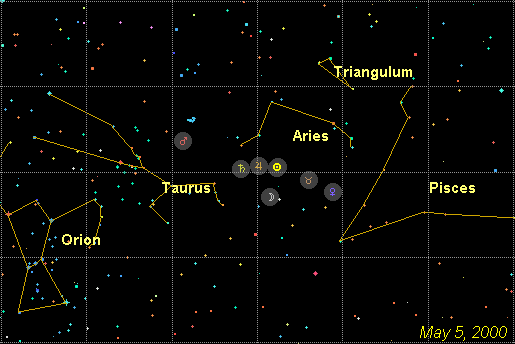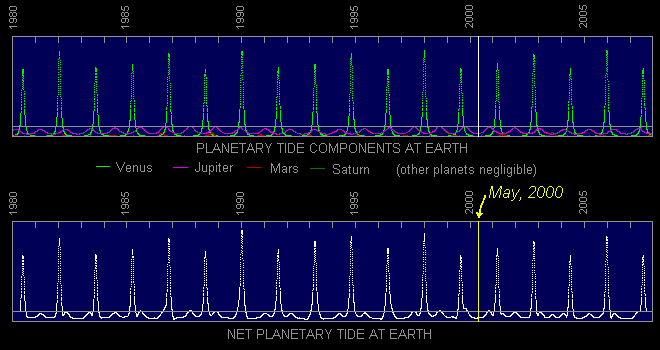
As the year 2000 approaches, the doomsayers and apocalypticians have begun to point to a variety of insignificant astronomical events and claim that these will cause disasters here on Earth. It's an old song not far removed from traditional astrology and really not deserving of much serious discussion, but it got me wondering how far from reality this tale actually is. First, there is indeed an interesting conjunction of the planets in early May of the year 2000. The star chart below (prepared using Maris Multimedia's Redshift software) shows the locations of the planets and the Sun and Moon on May 5, 2000. From left to right, Mars is in Taurus near the Pleiades. Saturn and Jupiter are just west of the Sun. The Moon is just south of the Sun, and Mercury and Venus are east of the Sun. If the Sun weren't in the way, this would be a really attractive sight.

All of the planets except Uranus, Neptune, and the non-planet Pluto are located within a few degrees of the Sun as seen from the Earth. This is also the date of New Moon so the Moon is right next to the Sun, too. Looks impressive until you notice that all of these objects except the Moon are on the far side of the Sun. So despite the fact that they're all relatively well aligned, they are farther from the Earth than usual. Their gravitational effect on the Earth --always tiny-- is even smaller than usual.
There are still a few questions to consider:
How strong is the gravitational influence of the other planets on
the Earth?? When does it peak? Is there any unusual enhancement of
gravitational influence at the time of any planetary alignments?
I calculated the tidal influence of each planet at the Earth over the course
of several centuries using standard almanac algorithms (only a few decades
are presented here). The tidal acceleration is proportional to the mass of
the planet, inversely proportional to the distance cubed, and also depends
on direction. We can calculate the driving force behind the ocean tides by
applying these factors for the Moon and Sun. For the planets, the graphs
below show the individual tidal components due to each planet and then the
maximum sum of those components accounting for the direction to each planet.
If it were large enough, this tide would add on to the tide from the
Sun and Moon and lead to subtle changes in the oceans and land masses down
here on Earth...

Notice the sharp spike from Venus every one-and-a-half years or so. This happens whenever the Earth passes close to Venus. Since the tidal force is inversely proportional to distance cubed, the close approaches between Venus and Earth are by far the most important factor in determining the net planetary tide at Earth. The net planetary tide in May, 2000 is actually quite a bit less than average since the planets are on the far side of the Sun, and it's about 15 times weaker than the tide at a typical Venus opposition.
The line at the top of each of the above graphs (roughly where the Venus spikes max out) corresponds to a tidal acceleration that is one ten-thousandth as strong as the Sun's average tidal acceleration on Earth (or over 20,000 times smaller than the tidal acceleration induced twice every day by the Moon). The low line on the graphs, close to the long-term average of the net planetary tide, is one one-hundred-thousandth of the average solar tide. So, as expected, the gravitational influence of the planets on the Earth is utterly insignificant. We're saved!